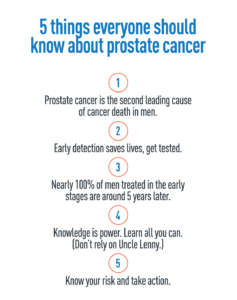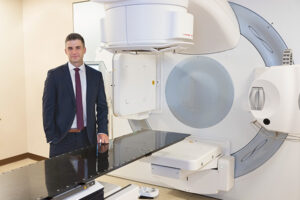Prostate Cancer Treatment Options
Fighting prostate cancer with pinpoint accuracy.
 At MRO, we use radiation to destroy cancer cells with high doses of radiation, the same type used for x-rays. Radiation therapy is highly effective in treating prostate cancer, and every year, more than 60,000 men in America choose this treatment. It’s a good option for older men who have other health issues, or heart problems which rule out surgery. Radiation treatment causes minimal side effects, so you can continue to work and maintain your regular schedule during treatment. It’s generally used in four cases:
At MRO, we use radiation to destroy cancer cells with high doses of radiation, the same type used for x-rays. Radiation therapy is highly effective in treating prostate cancer, and every year, more than 60,000 men in America choose this treatment. It’s a good option for older men who have other health issues, or heart problems which rule out surgery. Radiation treatment causes minimal side effects, so you can continue to work and maintain your regular schedule during treatment. It’s generally used in four cases:
- Localized prostate cancer – Radiation is often the primary treatment for disease that hasn’t spread outside the prostate.
- After surgery – Radiation treatment coupled with surgery is known as adjuvant therapy. Post-operative radiation is used to eliminate any cancer cells that may remain after a radical prostatectomy, to decrease the risk of recurrence.
- Along with hormone therapy– For men with a high risk of prostate cancer recurrence, hormone therapy is combined with radiation and makes a significant improvement in survival rates. Testosterone-suppressing drugs are prescribed to slow or stop the growth of the cancer.
- Advanced/Metastatic cancer – For men with advanced or metastatic prostate cancer, radiation is used to help ease pain, especially for cancer deposits in bones.
“As a radiation oncologist, I enjoy the opportunity to connect with patients on a personal level to provide the best possible care, and to use my knowledge of both physics and medicine to treat their prostate cancer with the most effective technologies.”
Jenna Borkenhagen, MD
MRO | St. Francis
At MRO, you have access to the most advanced technology available for cancer treatment. Using state-of-the-art imaging technologies, MRO doctors, dosimetrists, and physicists can pinpoint radiation doses down to the millimeter. We use two primary types of radiation therapy for prostate cancer:
 External beam radiotherapy (EBRT)– This is the most common form of radiation treatment for prostate cancer. At MRO, we use a machine called a linear accelerator (LINAC) to direct high-energy radiation at precise areas to destroy prostate cancer cells. We can shape the radiation beam to fit your tumor exactly and aim it at the tumor from different angles. This precision creates fewer side effects by sparing healthy tissue.
External beam radiotherapy (EBRT)– This is the most common form of radiation treatment for prostate cancer. At MRO, we use a machine called a linear accelerator (LINAC) to direct high-energy radiation at precise areas to destroy prostate cancer cells. We can shape the radiation beam to fit your tumor exactly and aim it at the tumor from different angles. This precision creates fewer side effects by sparing healthy tissue.
Internal radiation therapy or brachytherapy– Brachytherapy involves an operation where a radiation oncologist and urologist place radioactive pellets, or “seeds”, in the prostate. The seeds are about the size of a grain of rice and emit low-energy radiation for about six months. After that, they become essentially inactive and remain safely in place indefinitely. Immediately after this procedure, we recommend that you avoid close contact with pregnant women and children for a short time.
Sexual intercourse may resume following the implant. You should use a condom during intercourse for two weeks following the implant. You may experience slight pain with ejaculation the first few times you have intercourse. You may notice blood in the semen, this is not harmful.
“It is my privilege to lead our physics team with the goal of providing optimal patient care using state of the art technologies for safe and precise delivery of radiation therapy.”
Raj Varadhan, PHD, DABR, DABMP
DIRECTOR OF PHYSICS / TECHNOLOGY
In 1988, Minneapolis Radiation Oncology physicians pioneered the use of brachytherapy, also known as internal radiation therapy, for prostate cancer in Minnesota
Once the radiation oncologist has examined you, your MRO care team will explain treatment, discuss how sessions are scheduled, and provide information on how to take care of yourself during treatment.
Since radiotherapy for prostate cancer requires utmost precision, you’ll also go through a simulation at the MRO Therapy Center. Using image mapping as a guide, your care team will position you as you would be for treatment, take measurements to build a targeted treatment plan, and pinpoint the radiation for the best possible outcome and quality of life.
For prostate patients, treatments are typically five days a week, Monday through Friday, for 5 to 30 minutes. You’ll also meet with your MRO care team weekly to monitor progress and answer any questions you may